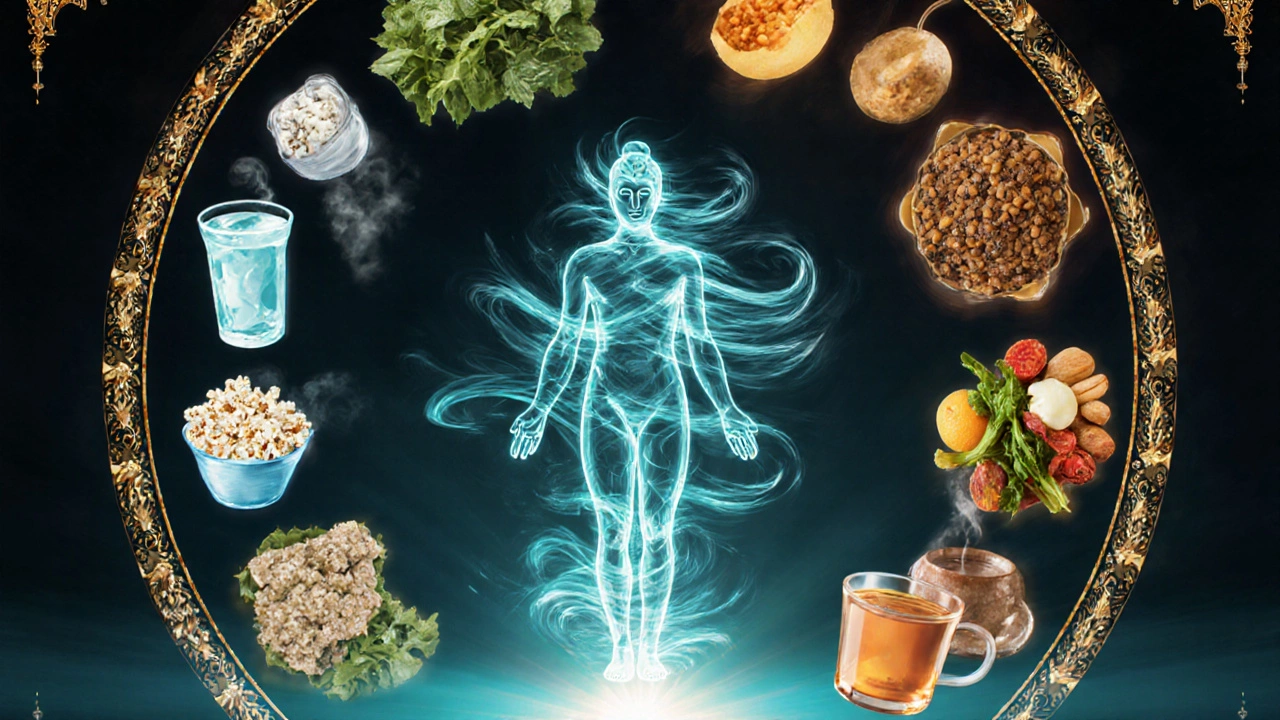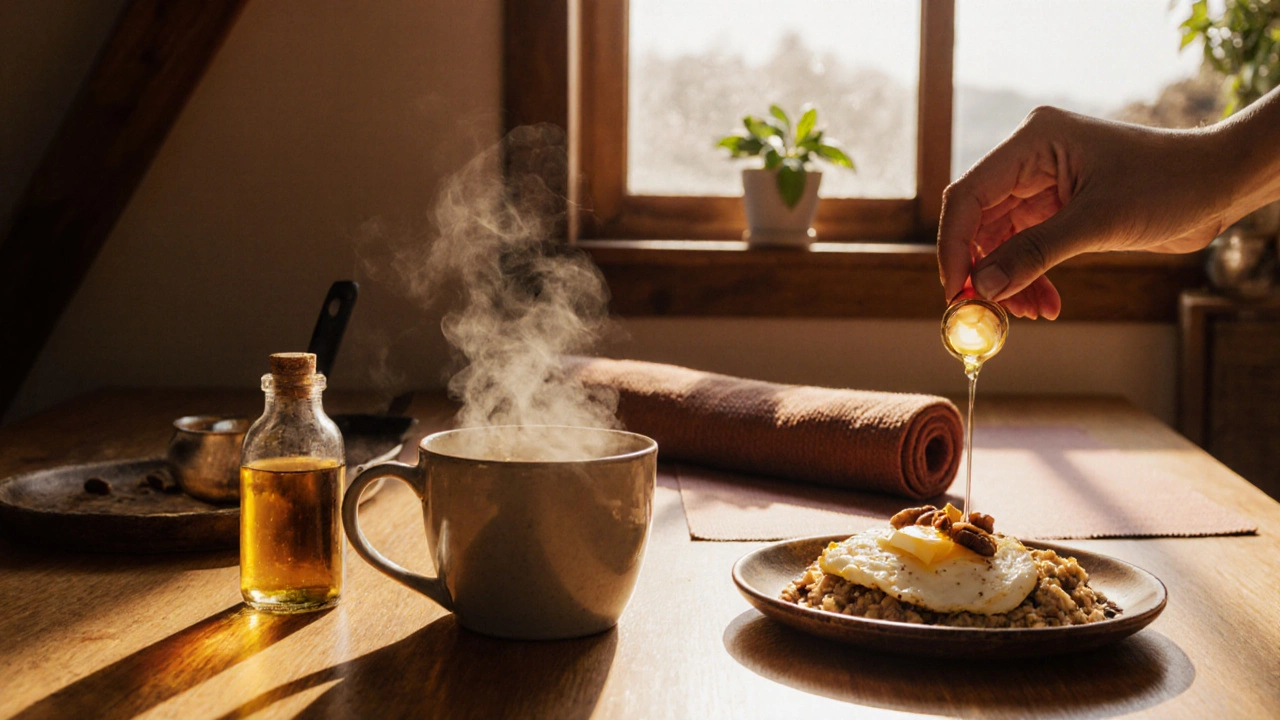-
1

Vata Dosha: Foods and Habits to Avoid for Balance
Vata Dosha Food & Habit Checker
Select an item from the dropdown and click "Check Item" to see if it's suitable for Vata balance.
Avoid Cold, dry, and raw foods
Support Warm, cooked, and oily foods
Moderate High-fat fried foods (in moderation)
Balance Regular meals, consistent sleep, grounding routines
Foods to Avoid
- Ice-cold drinks
- Raw salads (lettuce, cucumber)
- Popcorn, rice cakes
- Coffee & strong tea
- Alcohol (especially spirits)
- Processed sweets (candies, pastries)
- Dry beans & lentils (unsoaked)
- Cold fruits (watermelon, grapes)
- Leafy greens (spinach, kale) raw
Safe Foods & Habits
- Warm, cooked meals
- Oily, nourishing foods
- Regular meal timing
- Consistent sleep schedule
- Gentle exercise (yoga, walking)
- Warm herbal teas
- Grounding routines
- Abhyanga (self-massage)
- Screen-free evenings
When your Vata is the airy, mobile dosha in Ayurveda that governs movement, creativity, and communication, the right choices can keep you light and lively. The wrong ones, however, tip you into dryness, anxiety, and erratic energy. Below you’ll find exactly what to steer clear of so your Vata stays balanced.
Key Points
- Cold, dry, and raw foods destabilize Vata.
- Irregular meals and erratic sleep amplify Vata’s nervous qualities.
- Caffeine, alcohol, and processed sugars spike anxiety for Vata types.
- Warm, cooked, and oily foods, along with grounding routines, soothe Vata.
Understanding Vata and Its Sensitivities
In Ayurveda the ancient Indian system of health that classifies the body into three doshas - Vata, Pitta, and Kapha, each dosha has a distinct element profile. Vata is dominated by air and ether, which makes it quick, light, and change‑driven. Because air is inherently dry and cool, Vata naturally craves warmth, moisture, and stability. When you feed Vata with its opposite - cold, dry, or raw items - the dosha becomes aggravated, leading to symptoms like joint pain, constipation, nervousness, and insomnia.
Core Triggers Vata Should Avoid
Below is the master list of triggers that most Vata‑dominant people experience. Skipping these will prevent the most common Vata imbalances.
- Cold foods and drinks (ice‑water, raw salads, smoothies straight from the freezer).
- Dry, raw vegetables (celery, carrots, kale) that increase dryness.
- Light, airy snacks (crackers, popcorn, rice cakes) that add to lightness.
- Excessive caffeine (coffee, strong tea) that spikes nervous energy.
- Alcoholic beverages, especially when consumed on an empty stomach.
- Processed sugars and artificial sweeteners that create abrupt energy spikes.
- Frequent skipping of meals or erratic eating windows.
- Irregular sleep patterns - staying up late, inconsistent bedtime.
- Exposure to cold, windy climates without proper layering.
- High‑intensity, fast‑paced workout routines that over‑stimulate Vata.

Food Categories to Keep at Bay
Here’s a quick visual guide. The table lists common food groups, whether Vata should avoid them, and the reasoning behind each recommendation.
| Food Type | Should Avoid? | Why? |
|---|---|---|
| Ice‑cold drinks | Yes | Increases Vata’s cold quality, leading to digestion lag. |
| Raw salads (lettuce, cucumber) | Yes | Dry and light, they amplify Vata dryness. |
| Popcorn, rice cakes | Yes | Airy texture adds to Vata’s lightness. |
| Coffee & strong tea | Yes | Caffeine excites Vata’s nervous system. |
| Alcohol (especially spirits) | Yes | Dehydrates and destabilizes Vata’s moisture balance. |
| Processed sweets (candies, pastries) | Yes | Quick sugar spikes cause Vata anxiety. |
| Dry beans & lentils (unsoaked) | Yes | Hard to digest, increase gas and dryness. |
| Cold fruits (watermelon, grapes) | Yes | Cold nature aggravates Vata. |
| Leafy greens (spinach, kale) raw | Yes | High fiber, raw state is too rough for Vata. |
| High‑fat fried foods | No (in moderation) | Warm and oily, they can pacify Vata when eaten sparingly. |
Lifestyle Habits That Disturb Vata
Beyond the plate, daily habits shape Vata’s health. Below are the most common routine pitfalls and how to replace them.
- Skipping breakfast - Vata’s first fire of the day needs fuel. A warm, cooked breakfast (like oatmeal with ghee) stabilizes the morning surge.
- Irregular sleep - Aim for 10‑11hours when possible; go to bed by 10pm. Evening routines with warm oil massage (Abhyanga self‑massage with warm oil, a classic Vata‑soothing practice) calm the nervous system.
- Fast‑paced exercise - Swap high‑intensity cardio for gentle yoga, tai chi, or walking in nature. The goal is to move without creating excess wind.
- Excessive screen time - Blue light adds to mental restlessness. Use blue‑light filters and schedule screen‑free evenings.
- Chaotic work schedules - Keep a consistent daily timetable; even small rituals (morning tea, evening meditation) anchor Vata.
Seasonal & Climate Considerations
Because Vata is already cold and dry, certain environments can push it over the edge.
- Winter & windy weather - Wear layered, warm clothing and keep indoor humidity up with a humidifier.
- Dry desert trips - Hydrate often, sip warm herbal teas (ginger, cinnamon) instead of water.
- Travel across time zones - Stick to a Vata‑friendly routine: regular meals, warm fluids, and grounding activities like journaling.
Rebalancing Vata: Simple Daily Blueprint
Implement these eight steps every day and you’ll notice calmer nerves, steadier digestion, and better sleep.
- Start with a warm drink (ginger tea with a dash of ghee) within 30minutes of waking.
- Enjoy a cooked breakfast: oatmeal, spiced millet, or soft scrambled eggs with a spoonful of clarified butter.
- Eat meals at regular times - ideally every 3‑4hours. Include root vegetables, cooked greens, and healthy fats.
- Keep snacks simple: warm roasted nuts, dates soaked in almond milk.
- Limit caffeine to one cup before noon; switch to herbal teas afterward.
- Perform a 10‑minute Abhyanga before bedtime using sesame or almond oil.
- Wind down with a grounding practice - gentle yoga, deep breathing, or a short meditation.
- Sleep by 10pm, in a slightly cool (but not cold) room, with a light blanket for warmth.
Following this routine for a few weeks usually brings noticeable relief. If symptoms persist, consider a consultation with an Ayurvedic practitioner who can tailor herbs (like ashwagandha or shatavari) to your specific constitution.

Frequently Asked Questions
Can I enjoy fruits if I’m Vata?
Yes, but choose warm, ripe fruits like mango, papaya, or baked apples. Avoid cold, watery fruits such as watermelon and grapes, especially raw.
Is it okay for Vata to drink coffee?
Occasional coffee is fine if you limit it to one small cup before noon and pair it with a warm, oily snack. Over‑consumption will heighten nervousness and dry the gut.
What kind of exercise supports Vata balance?
Gentle, rhythmic activities work best: walking, swimming, yoga, tai chi, or slow cycling. Aim for 30 minutes most days, avoiding high‑impact sprinting.
Should Vata avoid all dairy?
Full‑fat, warm dairy (like warm milk with nutmeg or ghee‑based yogurt) can be soothing. Low‑fat, cold dairy tends to increase Vata's coldness and should be limited.
How long does it take to see results after changing my diet?
Most people notice calmer digestion and better sleep within 2‑3 weeks of consistent practice. Full mental clarity may take a month or more.